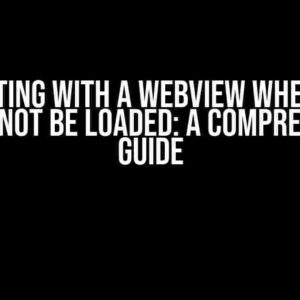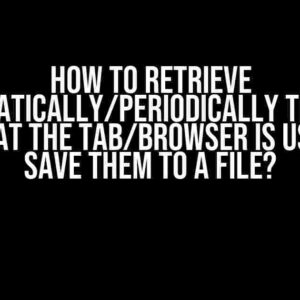Are you tired of manually testing your JavaScript code in the browser? Do you want to automate your testing process and ensure your code is error-free? Look no further! In this comprehensive guide, we’ll show you how to build a Mocha framework for browser testing. By the end of this article, you’ll be equipped with the knowledge to create a robust testing framework that will save you time and effort.
What is Mocha?
Mocha is a popular JavaScript testing framework that allows you to write and run tests for your code. It’s widely used in the industry and is compatible with various browsers and environments. Mocha provides a flexible and customizable way to test your JavaScript code, making it an ideal choice for browser testing.
Why Use Mocha for Browser Testing?
There are several reasons why Mocha is a great choice for browser testing:
- Easy to set up and use
- Fast and efficient testing
- Supports asynchronous testing
- Compatible with various browsers and environments
- Large community and extensive documentation
Step 1: Install Mocha
To get started, you’ll need to install Mocha. You can do this using npm (Node Package Manager) by running the following command in your terminal:
npm install --save-dev mochaThis will install Mocha as a development dependency in your project. Make sure you have Node.js installed on your system before running this command.
Step 2: Create a Test Folder
Create a new folder in your project directory to store your tests. Name it something like “test” or “specs”. This folder will contain all your test files.
mkdir testStep 3: Write Your First Test
Create a new file in your test folder called “example.spec.js”. This file will contain your first test:
touch test/example.spec.jsIn this file, add the following code:
describe('Example', function() {
it('should pass', function() {
expect(true).to.be.true;
});
});
This test uses the `describe` and `it` functions to define a test suite and a test, respectively. The `expect` function is used to assert that the value `true` is indeed `true`.
Step 4: Run Your Test
Run your test using Mocha by executing the following command in your terminal:
npx mocha test/example.spec.jsThis will run your test and output the results. You should see a passing test result.
Step 5: Configure Mocha for Browser Testing
To use Mocha for browser testing, you’ll need to configure it to run in a browser environment. Create a new file called “mocha.opts” in the root of your project:
touch mocha.optsAdd the following configuration to this file:
--require @babel/register
--ui qunit
-- reporter spec
This configuration tells Mocha to use the QUnit UI and the spec reporter. It also requires the `@babel/register` module to enable ES6+ syntax support.
Step 6: Write Browser Tests
Create a new file in your test folder called “browser.spec.js”. This file will contain your browser tests:
touch test/browser.spec.jsIn this file, add the following code:
describe('Browser Test', function() {
it('should run in the browser', function(done) {
document.body.innerHTML = '<h1>Hello World!</h1>';
expect(document.querySelector('h1').textContent).to.be.equal('Hello World!');
done();
});
});
This test uses the `document` object to create an HTML element and verify its content. The `done` function is used to indicate the end of the test.
Step 7: Run Browser Tests
Run your browser tests using Mocha by executing the following command in your terminal:
npx mocha test/browser.spec.js -- browsertype=chromeThis will run your browser tests in Chrome. You can also use other browsers like Firefox or Edge by specifying the `browsertype` option.
Step 8: Integrate with CI/CD
To automate your testing process, integrate Mocha with your CI/CD pipeline. You can use tools like Jenkins, Travis CI, or CircleCI to run your tests on each commit or push.
| CI/CD Tool | Integration Example |
|---|---|
| Jenkins | npm run test |
| Travis CI | script: npm run test |
| CircleCI | steps: npm run test |
This will ensure that your tests run automatically on each build, providing you with instant feedback on your code quality.
Conclusion
And that’s it! You’ve successfully built a Mocha framework for browser testing. By following these steps, you can automate your testing process and ensure your JavaScript code is error-free. Remember to integrate Mocha with your CI/CD pipeline to take your testing to the next level.
With Mocha, you can write robust and efficient tests for your browser code, saving you time and effort in the long run. So, what are you waiting for? Start building your Mocha framework today and take your testing to new heights!
Additional Resources
For more information on Mocha and browser testing, check out the following resources:
By following this guide and exploring these resources, you’ll be well on your way to becoming a master of Mocha and browser testing.
Frequently Asked Question
Get ready to brew a fresh cup of knowledge about building a Mocha framework for your browser!
What is Mocha and why do I need it for browser testing?
Mocha is a popular JavaScript testing framework that helps you write and run tests for your browser-based applications. You need Mocha because it allows you to ensure your code is working as expected, catch bugs, and improve overall code quality. With Mocha, you can write unit tests, integration tests, and even end-to-end tests to cover all aspects of your application.
What are the requirements to set up Mocha for browser testing?
To set up Mocha for browser testing, you’ll need to install Node.js, npm (the package manager for Node.js), and a testing framework like Mocha. You’ll also need a browser adapter like mocha-webpack or mocha-browser to run your tests in a real browser environment. Additionally, you might want to consider using a testing library like Chai or Expect.js to write more expressive assertions.
How do I configure Mocha to run tests in a browser?
To run Mocha tests in a browser, you’ll need to create a test runner that loads your test files and runs them in a browser environment. You can use a tool like mocha-webpack or mocha-browser to set up a test runner. Then, you’ll need to configure your test runner to load your test files, specify the browser adapter, and define the test environment.
Can I use Mocha with other testing libraries and frameworks?
Yes, Mocha is highly extensible and can be used with other testing libraries and frameworks. For example, you can use Mocha with Chai for assertions, Sinon.js for mocking, or Cypress for end-to-end testing. Mocha’s flexibility allows you to create a customized testing setup that fits your project’s needs.
How do I get started with building a Mocha framework for my browser-based application?
To get started, install Mocha and a browser adapter like mocha-webpack or mocha-browser using npm. Then, create a test runner that loads your test files and runs them in a browser environment. Start writing tests using Mocha’s API, and don’t hesitate to explore the Mocha documentation and community resources for help and inspiration.



